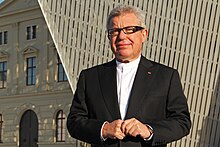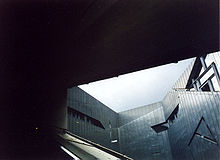Daniel Libeskind

Daniel Libeskind (born May 12, 1946 in Łódź , Poland ) is an American architect and urban planner of Polish- Jewish origin. He is known for his multidisciplinary approach to architecture. His main works include larger cultural institutions such as the Jewish Museum Berlin , the Felix-Nussbaum-Haus in Osnabrück, the Denver Art Museum and the Imperial War Museum North in Manchester, but also landscape and town planning as well as designs for exhibitions, stage sets and installations.
In the summer of 2002 he designed the set for Saint François d'Assise by Olivier Messiaen at the Deutsche Oper in Berlin. The first plans for the One World Trade Center in New York , which opened on November 3, 2014, were made by him, but since these could not be reconciled with the complex interests of those involved, the task was finally passed on to David Childs and Libeskind's role on the of a consultant in the overall planning. In 2014, a new building in the Kö-Bogen in Düsseldorf was completed according to his design .
Life

Libeskind was born on May 12, 1946 in Łódź (Poland). In 1957 the parents emigrated to Israel . Libeskind and his family moved to the United States in 1960 and took American citizenship in 1965. His mother was a political radical, socialist, and Zionist . In the United States, they lived in a cooperative apartment in the Bronx . He studied music in Israel and New York and worked as a professional musician, since he was a kind of prodigy on the accordion even as a child.
He later switched from music to architecture . In 1970 he graduated from the Cooper Union for the Advancement of Science and Art in New York City, and in 1972 a master's degree in architectural history and theory from the School of Comparative Studies at the University of Essex . From 1978 to 1985 Libeskind was Dean of the Architecture Faculty at the Cranbrook Academy of Art in Bloomfield Hills, Michigan. He received numerous honorary doctorates , for example from Humboldt University in 1997 and from his former alma mater , the University of Essex, in 1999 .
In 1989 he moved with his family to Berlin , where he founded the architecture office “Studio Daniel Libeskind”. He also taught as a professor at the Berlin-Weißensee School of Art . After winning the architectural tender for the new World Trade Center in February 2003, he relocated the headquarters to New York City, where he still lives today. There are branches in Zurich and Milan.
Libeskind taught at the universities of Yale , London , Zurich , St. Gallen , Graz , Berlin-Weißensee , Karlsruhe and Lüneburg , among others . At the Leuphana University of Lüneburg in 2007, Libeskind accepted the professorship in "Architectural Design" and now teaches there primarily in the start week as well as in complementary courses.
In 2010, Libeskind was awarded the Buber-Rosenzweig Medal : "Libeskind always succeeds in creating a dialogue between architecture and the history of the Jews through the inspiring spatiality of its work." (German Coordination Council for the award)
Architectural language
Daniel Libeskind's architecture is characterized by a narrative language of forms. It uses elements that explicitly refer to non-architectural content and thus receive a different semantic meaning. Examples of this are the “ Holocaust Tower” in the Jewish Museum Berlin or the height of the Freedom Towers (now One World Trade Center) that he designed as a new building for the destroyed World Trade Center , which - measured in American feet - is the year of the declaration of independence United States of America 1776 corresponds.
Libeskind's architectural drawings are often littered with verbal references that place his projects in a context other than that which is evident from the architecture itself. This approach also repeatedly leads to fierce controversies about its architecture. On the one hand, Libeskind is praised for his complex understanding of architecture, with which he opens up new possibilities of expression for architecture. On the other hand, he is often exposed to severe criticism. He is accused of overloading his projects with theories and incomprehensible symbolism that the users of his buildings do not understand. The ambitious claim and the built reality would not be congruent. During guided tours, parts of the building such as the Garden of Exile or the Holocaust Tower are explained to visitors . Libeskind is often referred to as a representative of deconstructivism , but he himself rejects this typification.
Works
- Verve , seven city villas with convex or concave curves, 75 luxury apartments, in Frankfurt am Main . In implementation.
- Leuphana University of Lüneburg: Central building with Audimax Opened on March 11, 2017.
- Sapphire , his first residential building in Europe, in Berlin-Mitte opposite the BND headquarters , with around 70 luxury apartments and a facade made of ceramic tiles with a titanium coating. Completed in 2017.
- Zlota 44 skyscraper in Warsaw , completed in 2016
- University of Milan . Installation Future Flowers, New Color For Oikos as part of Salone del Mobile 2015.
- Kö-Bogen I , Düsseldorf, opened in 2013
- Felix-Nussbaum-Haus, Osnabrück, extension, completed in 2011
- Reflections (Keppel Bay) a block of flats with high-rise and low-rise villas in Singapore . Completed 2011.
- Reconstruction of the main building of the Military History Museum of the Bundeswehr in Dresden , since mid-2004 until it reopened on October 15, 2011.
- Westside , a leisure and shopping center in Bern (new Brünnen quarter), Switzerland . Completed in 2008.
- Contemporary Jewish Museum , San Francisco , USA . Completed in 2008.
- The Ascent at Roebling's Bridge , a 22-story residential building in Covington , Kentucky. Opened in March 2008.
- Michael Lee-Chin Crystal , extension of the Royal Ontario Museum in Toronto , Canada . Completed in 2007.
- Frederic C. Hamilton Building , extension of the Denver Art Museum , USA. Completed in 2006.
- Maurice Wohl Convention Center of Bar Ilan University , Ramat Gan . Completed in 2005.
- Interior of the Jewish Museum Copenhagen in an armory from the 17th century. Completed 2004.
- London Metropolitan University in London , England . The graduate center was completed in March 2004.
- Studio Weil , with the work and exhibition rooms of the artist Barbara Weil on Mallorca , Spain . Completed in 2003.
- Memory Foundations , master plan for the redesign of the World Trade Center Site ("Ground Zero")
- Imperial War Museum North in the port area of Manchester , completed in 2001, designed as a layering of roofs with the association of a broken globe and the elements air, water, earth, which at the same time correspond to branches of service.
- Jewish Museum Berlin , completed in 1999. The basement is split into three diverging “axes”: the “axis of continuity”, the “axis of exile” and the “axis of the Holocaust”.
- Felix-Nussbaum-Haus , a museum of the city of Osnabrück , opened in 1998. Libeskind says: "The plan indicates the need to integrate the new and the old, beyond the respective external appearance." The Felix Nussbaum House was the first building he built and opened.
Projects
- The Spiral , extension of the Victoria and Albert Museum London . Draft from 1996/2004
- Concert hall MUSICON Bremen , designed in 1995
- JVC University in Guadalajara , Mexico
- Shoah Center in Manchester , England
- Participation in the reurbanization of the former SS area in Sachsenhausen
- Competition and contract for the Freedom Tower construction project on the World Trade Center site in New York , 2003; only consultants during the implementation
- Concept development for a campus of the future of the Leuphana University of Lüneburg
- Libeskind Villa , administration building of the Rheinzink company in Datteln
- Beth Shalom , reform synagogue in Munich
- Vanke Pavilion, EXPO 2015 (World Exhibition Milan)
literature
- Autobiography
- Daniel Libeskind: Outlines of my life. Autobiography. Publishing house Kiepenheuer and Witsch, Cologne 2004, ISBN 978-3-442-15364-0 .
- Draft and work
- Moritz Holfelder : Daniel Libeskind: Seismograph of historical tremors. DOM Publishers, Berlin 2010, audio CD with descriptions of buildings and interview passages by the architect about his working method, 75 minutes + booklet, ISBN 978-3-86922-123-6 .
- Individual buildings
- Elke Dorner: Daniel Libeskind - Jewish Museum Berlin . Gebr. Mann Verlag Berlin, 2006, 3rd edition, 112 pages with 54 illustrations, ISBN 3-7861-2532-5 .
- Studio Libeskind, Hélène Binet : Daniel Libeskind. Jewish Museum Berlin. Verlag der Kunst, Dresden 1999.
- Bernhard Schneider: Daniel Libeskind. Jewish Museum Berlin. Prestel publishing house, 1999. 64 pages. ISBN 3-7913-2073-4 (four chapters: 1. “A piece of new Berlin in a historical place”; 2. About the long path of its creation; 3. “New order between the lines”; 4. “In the innermost void “(Spatial conception) as well as data on the construction, vita of the architect).
- Interviews
- Gero von Boehm : Daniel Libeskind. December 9, 2009. Interview in: Encounters. Images of man from three decades . Collection Rolf Heyne, Munich 2012, ISBN 978-3-89910-443-1 , pp. 702-711.
- Sabine Gundlach: [1]
Web links
- Official homepage of Daniel Libeskind
- “Daniel Libeskind. Late bloomer from the Bronx ” , FAZ , November 24, 2008, with photo series
- Biographical information on Libeskind and the Musicon project in Bremen , 2003
- Libeskind dossier with a focus on Ground Zero , arte , 2003
- Literature by and about Daniel Libeskind in the catalog of the German National Library
- For the award of the Buber Rosenzweig Medal
- FAZ campaign Smart Minds
- Buildings, projects
- LibeskindVilla
- “Built cliffs and glass waves” , FAZ , December 13, 2006, with photo gallery: Hamilton Building, Denver and Institute of Contemporary Art, Boston
- Information on the renovation of the Military History Museum in Dresden
- WestSide project in Bern, Switzerland
- Felix Nussbaum House Osnabrück
- Danish Jewish Museum in Copenhagen
Individual evidence
- ↑ So Libeskind's plans were changed again and again, which delayed the start of construction. The plans were mainly called into question because Libeskind had almost no experience in building high-rise buildings and the main tower he designed did not have enough rentable space.
- ↑ The new World Trade Center has its tip
- ↑ Daniel Libeskind in an interview, Tagesspiegel of February 27, 2005
- ↑ See his biography: Drafts of my Life.
- ↑ Leuphana Lüneburg website ( page no longer available , search in web archives ) Info: The link was automatically marked as defective. Please check the link according to the instructions and then remove this notice.
- ↑ see literature references: Daniel Libeskind, Breaking Ground, Cologne 2004, ISBN 3-462-03411-1 here page 216 f.
- ↑ Website on the construction project: verve-frankfurt.de , accessed on September 19, 2017.
- ↑ FAS: Daniel Libeskind: "I am not neutral" on Frankfurter Allgemeine Zeitung of November 28, 2016, accessed on September 19, 2017.
- ↑ spiegel.de: Libeskind's weird castle in the air.
- ↑ Construction supervision approves immediate use of the Libeskind building . ( leuphana.de [accessed on February 4, 2017]).
- ↑ Website for the construction project: sapphire-berlin.com , accessed on November 25, 2016.
- ↑ Benjamin Bidder: Star architect Libeskind on gentrification - "Build higher, then the city will remain affordable". On Spiegel Online on November 12, 2016, accessed on November 25, 2016.
- ↑ Hildburg Bruns: Here interested parties gamble for luxury apartments. In: Berliner Zeitung of October 1, 2015, accessed on November 26, 2016.
- ↑ Military History Museum of the Bundeswehr , viewed on August 20, 2011.
- ↑ Neue Osnabrücker Nachrichten , May 8, 2011, p. 27.
| personal data | |
|---|---|
| SURNAME | Libeskind, Daniel |
| BRIEF DESCRIPTION | American architect of deconstructivism |
| DATE OF BIRTH | May 12, 1946 |
| PLACE OF BIRTH | Łódź , Poland |



